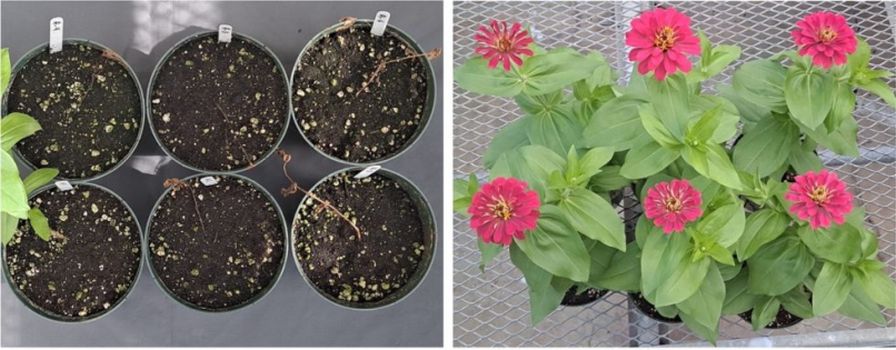How Disinfesting Your Soil May Reduce Pathogens in Specialty Cut Flowers

Example of the level of disease severity observed in zinnia plants grown in ASD-treated (right) and control (left) substrates.
Note: This article originally appeared American Floral Endowment’s website, and was written by Francesca Peduto Hand, Associate Professor, Ornamental Crops Pathology | Department of Plant Pathology, The Ohio State University.
Within the U.S. floriculture industry, cut flowers account for more than $382 million in annual national sales. Although imported cut flowers make up the majority of purchases, locally grown specialty cut flowers are facing a tremendous increase in popularity. This phenomenon is well reflected in the number of members of the Association of Specialty Cut Flower Growers (ASCFG), which has increased by more than 100% in the last five years.
Specialty cut flower production systems are diverse and include the use of soilless, soil-based, or a combination of these substrates, which can be reused over multiple seasons. Along with substrate reuse, the use of soil can introduce the risk of soilborne diseases caused by fungi and oomycete pathogens. Most of these pathogens need to build up high levels of inoculum (i.e., pathogen propagules) before causing noticeable disease, which can happen very quickly in intensive farming systems with limited rotations. Management of soilborne pathogens in agricultural settings has historically relied on the use of chemical fumigation. This practice is very harmful to soil health because the chemical products used for soil disinfestation are nonselective and indiscriminately kill every organism, including beneficial microbes. This reason, combined with increased concerns for human and environmental health, has led many growers to adopt more sustainable farming practices. Therefore, there is a need for environmentally sound disease management tools that can be integrated into sustainable farming.
One promising non-chemical alternative to soil fumigation is anaerobic soil disinfestation (ASD). ASD is a pre-plant soil treatment that consists of three steps. First, an easily decomposable carbon amendment is incorporated into the soil. Then, the soil is irrigated to saturation and tarped to prevent the resupply of oxygen. The creation of anaerobic conditions and their maintenance over several weeks induces a change in the soil microbial composition, prompting a shift from aerobic to anaerobic microorganisms. The accumulation of toxic compounds during the anaerobic incubation, and the antagonism that anaerobes express towards plant pathogens, have been shown to have an effect in decreasing the survival of these pathogenic organisms in the soil. In contrast with chemical fumigation, ASD has less effect on untargeted soil microorganisms, which makes this method better for the soil environment.
ASD has been tested in recent years in many cropping systems, mainly greenhouse and field-grown vegetables and field-grown strawberries. However, it has not been sufficiently investigated in ornamentals, and only a few studies have been published to date, specifically in cut flower production systems. None of these studies were carried out in the temperate climates of the Midwestern and Eastern U.S. When ASD is introduced to a new region and cropping system, it must be evaluated due to differences in climate, soil conditions, available carbon sources, and pathogens present. Carbon amendment is one of the key variables in ASD efficacy since the type of carbon source will influence the kind of toxic compounds that are generated during incubation, as well as the maintenance of anaerobic conditions. Many carbon sources have been tested with successful results; however, the availability of the carbon amendment has a major role in driving their selection. To this end, by-products of local agricultural commodities can be employed as carbon sources as they are low-cost and locally available, which are key factors to facilitate farmer adoption of this technique.
Research funded by the American Flower Endowment and the Association of Specialty Cut Flower Growers at The Ohio State University is evaluating the suitability of ASD for soilborne disease management in the production of specialty cut flowers in temperate regions. In the last year, a fungal and an oomycete pathosystem (Rhizoctonia solani – zinnia and Phytophthora drechsleri – gerbera daisy) were used as models in controlled environmental settings to evaluate ASD efficacy in both soilless and soil-based plant production. Each substrate was mixed with pathogen inoculum and amended with either wheat bran, tomato pomace, or soybean meal as the carbon source. Amended substrates were incubated at 77°F for four weeks and then used as growing substrates for the two crops, which were monitored weekly for disease development for up to five weeks post-transplant.
Results showed that ASD was effective at controlling Rhizoctonia stem rot on zinnia plants when tomato pomace and wheat bran were used as carbon sources in both soilless and soil-based substrates, compared to the same substrates that were not amended with any carbon sources. Conversely to what was observed for Rhizoctonia stem rot, ASD was not effective at controlling Phytophthora crown rot on gerbera daisy regardless of the carbon amendment or the type of substrate used. The severity of soilborne diseases is influenced by several factors, such as plant developmental stage, environmental conditions, and levels of inoculum. Following the results from the initial experiments, we evaluated whether the rate of inoculum in the substrate and the transplanting age of gerbera daisy could affect Phytophthora crown rot progress in select ASD treatments. Wheat bran was selected as the carbon source for these follow-up experiments because it is a proven ASD standard. Results showed that ASD could be effective when low amounts of inoculum are present in the substrate. However, they also highlighted the need for additional research to be conducted to understand how different carbon amendments and inoculum thresholds can influence ASD efficacy in controlling this very aggressive oomycete pathogen.
Additional experiments are planned for the spring-summer of 2023 to evaluate the performance of ASD in the outdoor production of zinnia and snapdragon in raised beds.








